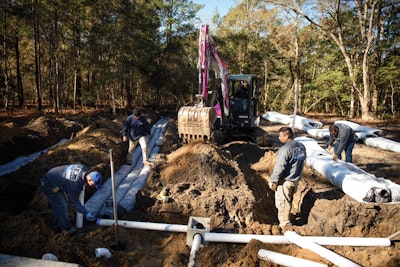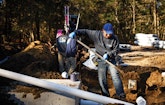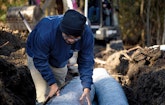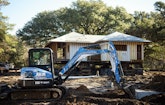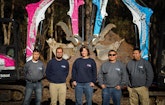
Interested in Systems/ATUs?
Get Systems/ATUs articles, news and videos right in your inbox! Sign up now.
Systems/ATUs + Get AlertsTo Courtney Stephenson, success in business is simple: “My goals are to do a job well, make a decent living, help my employees support their families, and enjoy what I do. That is success.”
Satisfied customers around Holly Ridge near the North Carolina coast might say there’s a lot more to it than that. Her company, Atlantic On Site Services, has earned a reputation for quality work on everything from simple conventional systems to advanced aerobic treatment systems on challenging lots, to multiple systems for sprawling RV campgrounds.
Stephenson and a team of four equipment operators and field workers install 350 onsite systems per year, working mostly with homebuilders and often installing systems in bunches for subdivisions with houses constructed on speculation.
She thrives on challenges, and the coastal region’s high water table and sandy soils bring plenty of them. Always willing to try new approaches, she installs a wide variety of aerobic treatment units, even if that means being first in the state to try a new technology.
Rooted in Science
The onsite business wasn’t on Stephenson’s radar when she graduated from the University of North Carolina at Chapel Hill in 1999 with a bachelor’s degree in biology and a chemistry minor. She went to work doing research in the chemical industry. After a layoff in 2004, Stephenson and a partner started the onsite business she owns today. The partnership later dissolved and she became sole owner.
The company now works almost anywhere between Holly Ridge and Raleigh, the state capital. “The more jobs I did, the more I loved being outside, the physical nature of the work, starting and finishing projects and seeing what I accomplished every day,” she says.
“As I learned more about the industry, I realized how relevant my degree was to it. Water treatment is all about chemical and biological processes. The advanced systems especially are about using some type of media and some type of bacteria and process in a physical product that brings in dirty water and spits out clean water. I have the education to understand how that happens and how it helps the environment. It even makes my parents a little happy, considering they sent me to college, that my four-year degree wasn’t wasted.”
Learning by Doing
Still, there was the matter of learning the techniques of installing systems. Her partner had experience in the industry, but after they parted ways, she was largely on her own. “As my experience grew, I came in contact with more and more engineers and developers who needed more complex systems in order to build a house, a duplex or an apartment building,” she recalls.
“I learned by doing. If a permit was written and called for an advanced system, I call up the manufacturer and say, ‘Look, I’m going to be putting in one of your systems.’ They’d come on site and help on the first one. The more I did, the more I learned. I also proved that I was trustworthy and would do the job right.
“I am a Type A, highly driven, motivated person. Failure is not an option in my life. If I’m going to do something, I’m going to do it 100 percent. I want to know all about it that I can. I don’t settle for mediocrity. If there’s something new out there, if there’s a challenge or a risk, I want to take it on.”
Atlantic On Site was the first in North Carolina to install a compact membrane bioreactor from BUSSE Green Technologies. The system was installed as a replacement on a lakefront lot with extremely constrained space and poor soil conditions. The BUSSE unit, with aeration and membrane filtration steps, was installed in the property owner’s garage.
Stephenson also installed one of the first Hydro-Action aerobic treatment units in the state.
She also installs E-Z Treat sand filters, AdvanTex AX20 and AX100 units (Orenco Systems), Singulair systems (Norweco), and Anua and Ecoflo (Premier Tech Aqua) peat systems, along with many American Perc-Rite (American Manufacturing Co.) and Geoflow drip dispersal fields.
Gaining Credentials
During her early years in the business, North Carolina didn’t offer credentialing for onsite installers. When the state began doing so in 2008, Stephenson was in one of the first classes and earned Level IV (highest) certification, qualifying her to install essentially any onsite system that can be permitted in the state: “I went for the top-level certification because I didn’t want to be limited in what I could do.”
She continues learning by attending the annual Onsite Water Protection Conference in Raleigh, along with North Carolina Septic Tank Association conferences and, two years ago, the Water & Water & Wastewater Equipment, Treatment & Transport Show in Indianapolis. “I always look for ways to improve my business,” she says.
Meanwhile, she keeps learning on her own and developing her team. “As our company grew, I added equipment and trucks, and I decided that if I was going to own equipment I was going to know how to run it. If I own a big truck, I’m going to know how to drive it.”
Among her team members, foreman Israel Cruz and assistant foreman Jesus Pina are the primary equipment operators, although Stephenson wants the other crew members, Steven Cruz and Luis Lopez, to learn the equipment as well.
Besides running excavators, Israel Cruz coordinates daily installs, calls county health department personnel for inspections, orders tanks, and generally makes sure jobs get done. Pina covers up and closes jobs using the skid-steer and makes sure installed systems run efficiently and correctly. Steven Cruz is the pump and panel specialist.
For drainfields they use EZflow media or chambers (both from Infiltrator Water Technologies) almost exclusively. “The majority are EZflow,” says Stephenson. “Most times the determining factor is logistics. With chambers I can haul enough for up to three systems per day. EZflow is a little more challenging to haul. I always use the material my customer prefers, but we really only use rock if it is requested.” For tanks she prefers concrete.
Tackling Big Jobs
Stephenson doesn’t design systems. In North Carolina, county environmental health department staff members typically perform the soil tests and prescribe the systems; installers are largely limited to implementing permitted plans. The challenges come in dealing with the site conditions. Along the coast, tank excavations often require extensive dewatering.
That was the case last summer when Atlantic On Site installed treatment systems for 125 sites in the second phase of the Turkey Point RV Park at Sneads Ferry; the company had also built the first-phase systems. The second phase included 13 septic systems with conventional drainfields using a mix of EZflow media and chambers.
“That job was challenging because it’s right down on the intercoastal waterway in sand,” Stephenson said. “Setting the 26 tanks was the most difficult part. Every tank had to be wellpointed and dewatered. We had to use trench boxes and dig 12- to 15-foot-deep holes.”
Wellpointing for each hole meant driving a series of wellpoints around the perimeter of the excavation, connecting each one to a manifold and hooking that to a large suction pump to pull the groundwater away from the hole to dry it out. Based on her experience at Turkey Point and other sites, Stephenson has added wellpointing as a specialized service.
Last year’s projects included two other RV parks: a conventional system for a park with 25 sites and a conventional system and drip dispersal system for a park with 37 sites. The team also installed a sewer line nearly a mile long, an E-Z Treat system and a spray irrigation field with a dozen spray heads for a private hunt camp.
Landing Business
All this and more traditional work for homes and subdivisions has come about largely through shoe leather and referrals; Atlantic On Site does no media advertising. Stephenson observes, “In the past 12 years, the main marketing I’ve done is going to subdivisions, walking up to builders and saying, ‘Hey, this is my company — can I price your septic systems?’
“We’ve operated off word-of-mouth and soliciting work in person. I’ll pull building permits and ride around, and I’ll just cold-call people. When I go to conferences, I make it a point to talk to designers and engineers. Sometimes they call me back and sometimes they don’t. If not, I’ll call them and say, ‘I’d like to price something for you.’
“I’ve mainly stayed with new construction. Builders talk among themselves. Over time, some builders have given my name out. I do a lot of work for tract builders who buy large pieces of land and build subdivisions.”
Stephenson thrives on new challenges.
“You never know what you’re going to run into underground,” she says. “You never know if you’re going to hit water or hit rock. I really just love what I do because it’s challenging. It keeps me outside and in different places. It keeps me in shape, and I can see what I’ve done at the end of the day.”
Her advice to others in the profession: “Success in any business is pretty much based on doing what you say you’re going to do and being honest and straight-up with customers. As long as you adhere to that, you can be successful in anything.”
The right tools
Knowledge, skills and experience count in the onsite installation business, but to Courtney Stephenson, another ingredient is critical.
“Having the right tools and equipment is the best way to get a job done,” says Stephenson, owner of Atlantic On Site Services. “The machines I’ve chosen I find to be the most versatile, compact and convenient.”
Her fleet includes a pair of 12,000-pound Bobcat E50 mini-excavators, model years 2012 and 2016, and a 35,000-pound Case 160 excavator for clearing trees and digging deep holes on large projects. A Takeuchi TL 140 skid-steer loader helps make site work efficient.
“The two mini-excavators I can haul behind my truck,” Stephenson says. “I can get them into just about any place I’ve needed to go in my 12 years. They can go through fence gates. They’re on rubber tracks, so they do the least damage. I can cross a driveway if I need to. They also seem to have the best power for their size. I use them every day.”
The company also owns 2002 and 2015 Ford F-450 pickups, a 2001 International road tractor with a 40-foot trailer, a 1995 Chevy Kodiak dump truck, and two 7-ton equipment trailers (Hudson and Proline).
Looking to raise her profile, Stephenson recently hired Kixx Outfitters, a local sign and screening shop, to put a hot pink wrap on one of the mini-excavators. “I’m a girl in a man’s industry, and I thought it would be kind of cool to have a pink excavator,” she says. “I hoped it would help my marketing a little bit. There’s some expense involved, but it makes for great advertising.”
She liked the work so well that she hired Kixx to wrap the other Bobcat machine — in blue.
